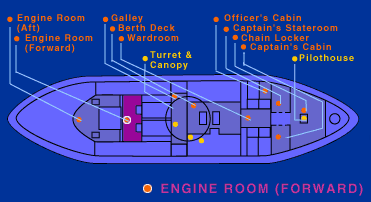 |

|

|
 |
|
Intro |
Galley |
Deck |
Canopy |
Wardroom |
Officer's Cabin |
Captain's Cabin |
Captain's Stateroom |
Turret |
Pilothouse |
Chain Locker |
Berth Deck |
Engine Room - Forward |
Engine Room - Aft Engine Room (Forward) The "fire room," which comprised the forward end of the engine room, lay immediately aft of the boilers. Here crew tended the Monitor's boilers and controlled the main engine. Both required considerable maintenance. Crew members continually fed the boiler fires and tended the coals, while engineers and sailors monitored the various pressure and temperature gauges on an hourly basis. As on the berth deck, all lighting in the engineering areas was artificial, and the iron walls bore white paint to reflect what little light there was. In good weather, one could open the crew's hatch in the overhead, but the area mostly remained sealed so the blowers could efficiently fan the furnace fires. Aft of the boilers was the Monitor's main engine. Another original conception of the ship's inventor John Ericsson, the engine was not unique in design but it was unique for then-modern naval warships. The vibrating side-lever engine had one main cylinder that housed two pistons operating on a horizontal plane instead of the more traditional vertical plane. On each side of the engine lay a "rock shaft," which a short arm connected to the piston trunk. At the aft end of the rock shafts, arms attached to the propeller shaft via connecting rods. As the pistons slid back and forth, the rocking motion translated into rotation at the propeller shaft. The vibrating side-lever engine allowed rotation of the propeller shaft to be applied at a 90-degree angle to the main cylinder, while the horizontal design of the cylinders enabled Ericsson to place all of the machinery low in the hull below waterline and behind the Monitor's protective armor. At the back of the engine was the valve chest. This area was "operation central" for the main machinery. Using a series of levers, cranks, and wheels, the men worked the vibrating side-lever engine at the captain's whim. Below the valve chest lay two of the Monitor's bilge pumps. These pumps were rated at 2,500 gallons per minute, more than capable of keeping the bilges dry. Ericsson also equipped the ship with a centrifugal bilge pump that was rated at over 3,500 gallons per minute. The blower drive pumps were mounted floor-to-ceiling at the outboard sides of the fire room. The small steam engines drove the large blowers with thick leather belts. The engine itself stood on a raised platform, which crew members accessed via a set of stairs on the starboard side. From this area, sailors had access to all of the main engine's moving parts. Vigilance was essential during operation of the main engine. The engineering crew had to ensure all moving parts were sufficiently lubricated for peak performance. A damaged piece of machinery could take weeks to replace, as most of the parts would have to be fabricated. Tour the Monitor | Behind the Scenes Eyewitness to the Battle | Steam Machine | Resources Transcript | Site Map | Lincoln's Secret Weapon Home Previous Sites | Adventures | Join Us/E-mail | TV/Web Schedule Teachers | Site Map | Search | Shop | To print PBS Online | NOVA Online | WGBH © | Updated October 2000 |
||